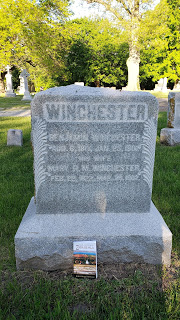 |
| Benjamin Winchester grave with Lost City of Zarahemla |
I was in Iowa the other day so I stopped by the burial site of Benjamin Winchester. It’s only a few miles from the Winter Quarters, Nebraska, temple and visitors center. (Those are worth a visit if you are ever in the area.)
The first book I wrote about Church history, The Lost City of Zarahemla, focused on the infamous 1842 anonymous articles in the Times and Seasons that our M2C intellectuals have attributed to Joseph Smith. I propose instead that these articles were written by Benjamin Winchester, who was living in Philadelphia at the time.
Although Joseph Smith is listed in the boilerplate of the Times and Seasons during part of 1842, he is also listed as the printer and publisher of the newspaper. Nobody claims Joseph actually set type and ran the printing press. He was the nominal printer, meaning the printer in name only. In the same way, I think he was the nominal editor. He didn’t have the time, interest, or talent to edit the newspaper.
Instead, I think his brother William, who was publishing another newspaper from the same printing ship in Nauvoo (titled The Wasp), was the actual editor of the Times and Seasons. At some point, W.W. Phelps came to Nauvoo and undoubtedly assisted. Winchester would mail material to William Smith, who, together with Phelps, edited it for publication. That’s why these articles were published anonymously, just like all the other Winchester articles. (Winchester was the second most published author in the Times and Seasons through 1842, next to Joseph Smith. The very first issue of the Times and Seasons contained a letter he wrote.)
Our M2C friends whose theory originated from the anonymous articles in the 1842 Times and Seasons continue to insist that Joseph wrote them. Some of them concocted a “stylometry” study to prove their theory, except they still refuse to disclose their data, assumptions, and software.
My conclusion required Winchester to be sending material to Nauvoo. We don’t have the original sources for most of what was published in the Times and Seasons. The Wentworth letter, for example, exists only in the Times and Seasons. Presumably it was written by hand, and presumably it was an edited version of Orson Pratt’s missionary pamphlet, but we don’t have any pre-publication materials.
If we did, I suspect we would find the materials Winchester mailed to Nauvoo from Philadelphia. That remains speculation unless and until those pre-publication materials are found.
 |
| Winchester letter 8 August 1842 |
However, after I published the first edition of the book, a letter from Winchester turned up. He mailed it from Philadelphia to Nauvoo, addressed to the “first presidency.” It was dated 8 August 1842. That’s right in the time frame for the anonymous articles. It corroborates, but does not prove, my conclusions.
You can see the letter in the Joseph Smith papers, here:
https://www.josephsmithpapers.org/paper-summary/letter-from-benjamin-winchester-8-august-1842/1#facts
I’ll have more to say about this topic later this week.
Source: About Central America
